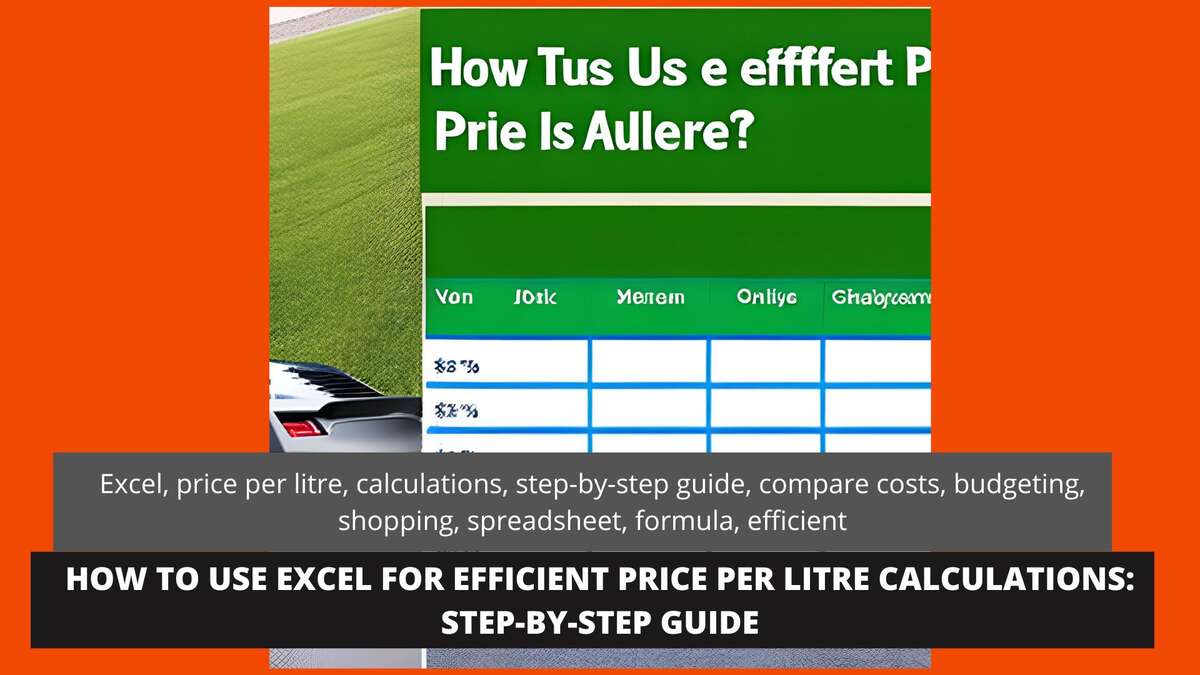Microsoft Excel is a powerful tool that can help you manage and analyze data efficiently. One of its many applications is calculating the price per litre for various products, allowing you to compare costs and make informed purchasing decisions. In this step-by-step guide, we'll walk you through the process of using Excel to perform price per litre calculations with ease. Plus, check out our online Price Per Litre Calculator for quick and accurate results.
Understanding the Price Per Litre Formula
Before diving into Excel, it's essential to understand the formula used for calculating the price per litre. The price per litre is the cost of a product for every litre of volume or weight, expressed in dollars or other currencies. The formula is as follows:
Price per litre = Total price per unit / Total weight per unit
Where:
- Price per litre is the cost per one litre, given in dollars or other currencies
- Total price per unit is the price at which you purchased the product
- Total weight per unit is the weight or volume of the entire product you bought
Setting Up Your Excel Spreadsheet
To begin, open Microsoft Excel and create a new spreadsheet. Label the columns as follows:
- Product Name
- Total Price Per Unit
- Total Weight Per Unit (Litres)
- Price Per Litre
These columns will help you organize your data and perform the necessary calculations.
Step 1: Input Your Data
Enter the product names, total prices per unit, and total weights per unit (in litres) for each product you'd like to compare. List each product in a separate row under the corresponding column headers.
Step 2: Create the Price Per Litre Formula in Excel
In the first empty cell under the "Price Per Litre" column, type the following formula:
=B2/C2
This formula divides the total price per unit (B2) by the total weight per unit (C2) to calculate the price per litre.
Step 3: Apply the Formula to All Products
After typing the formula in the first cell, click on the cell to select it. Then, move your cursor to the bottom-right corner of the cell until it turns into a plus sign (+). Click and drag the plus sign down to fill in the formula for all the products listed in your spreadsheet.
Excel will automatically adjust the formula to reference the correct cells in each row, calculating the price per litre for each product.
Step 4: Format the Price Per Litre Column
To improve readability, format the "Price Per Litre" column to display the results as currency values with two decimal places. To do this, follow these steps:
- Select the entire "Price Per Litre" column by clicking the column header.
- Click the "Home" tab in the Excel ribbon.
- In the "Number" group, click the drop-down arrow next to the "Number Format" box and select "Currency" or the desired currency format.
- Ensure that the "Decimal Places" box is set to 2.
Your price per litre calculations should now be formatted as currency values with two decimal places, making it easier to read and compare the results.
Step 5: Sort and Analyze Your Data
Now that you have calculated the price per litre for each product, you can sort and analyze the data to make informed purchasing decisions. To sort the data by price per litre, follow these steps:
- Select any cell within the "Price Per Litre" column.
- Click the "Data" tab in the Excel ribbon.
- In the "Sort & Filter" group, click "Sort Smallest to Largest" or "Sort Largest to Smallest," depending on your preference.
Your data will now be sorted by the price per litre, allowing you to compare costs and identify the best value for your money.
Additional Excel Tips for Efficient Price Per Litre Calculations
Beyond the basic steps outlined above, here are some additional Excel tips to help you make the most of your price per litre calculations:
- Use conditional formatting: Apply color scales or data bars to the "Price Per Litre" column to visually highlight the most and least expensive products.
- Create charts and graphs: Visualize your data using Excel's chart and graph features to better understand price trends and patterns.
- Monitor price changes over time: Keep a record of historical price data in your spreadsheet to track price fluctuations and identify the best time to buy certain products.
Conclusion
Microsoft Excel is an invaluable tool for performing efficient price per litre calculations, helping you make informed purchasing decisions and optimize your budget. By following this step-by-step guide and utilizing Excel's powerful features, you can quickly and easily compare product costs and identify the best value for your money. Don't forget to check out our online Price Per Litre Calculator for even faster results!
